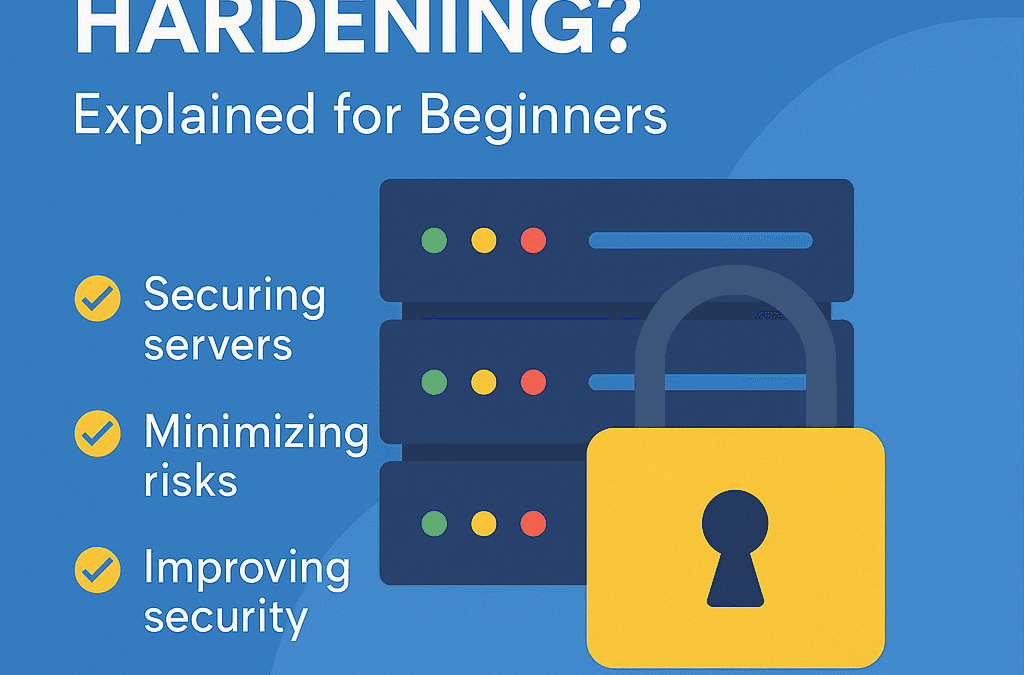Whether you’re setting up your first web server or managing a fleet of machines, the term “server hardening” is one you’ll encounter early and often. But what is server hardening, really? And why is it a must-do task for anyone serious about cybersecurity?
Let’s break it all down in this beginner-friendly guide.
Understanding the Basics of Server Hardening
At its core, server hardening is the process of securing a server by reducing its vulnerabilities. Think of it like locking the doors and windows of your house—not because you’re paranoid, but because it’s the smart thing to do.
Servers come with a wide range of services, software, and configurations. Many of these are unnecessary or insecure by default. Hardening means removing what you don’t need and tightening the rest.
Why Is Server Hardening Important?
The stakes are high when it comes to server security. Here’s why hardening is essential:
-
Prevents unauthorized access to sensitive data
-
Blocks malware and brute-force attacks
-
Reduces attack surface area
-
Ensures compliance with laws like GDPR, HIPAA, and PCI-DSS
-
Minimizes downtime and data loss
In short, it protects your business reputation and user trust.
Key Components of Server Hardening
Server hardening involves multiple layers of defense:
-
Disabling unnecessary services
-
Closing unused ports
-
Removing default user accounts
-
Applying security patches
-
Configuring firewalls
-
Enforcing password and access policies
It’s a combination of cleaning, tightening, and maintaining.
Common Threats Mitigated by Server Hardening
Without proper hardening, your server is a sitting duck. Here are threats that hardening helps prevent:
| Threat | Description |
|---|---|
| Brute-force attacks | Automated login attempts to guess passwords |
| Malware | Exploits unpatched software to take control |
| Misconfiguration | Default settings that expose services or data |
| Privilege escalation | Gaining admin access through weak user settings |
| Denial of Service (DoS) | Overloading servers through open services |
Physical vs Logical Hardening Explained
-
Physical hardening: Restricts who can physically access servers. Includes locking server rooms, using CCTV, and biometric access.
-
Logical hardening: Involves software-level changes like password policies, encryption, and firewall rules.
Both are critical—digital locks are useless if someone can just unplug your server.
Operating System Hardening
Different OSes need tailored hardening steps:
️ Linux:
-
Use SELinux or AppArmor
-
Disable root login via SSH
-
Apply
ufworiptablesfor firewall
Windows Server:
-
Disable SMBv1
-
Enforce password complexity via Group Policy
-
Turn on Windows Defender or third-party antivirus
Network and Firewall Configuration
Firewalls act as gatekeepers.
-
Block all incoming traffic by default
-
Allow only specific ports (e.g., 80 for HTTP, 443 for HTTPS)
-
Use tools like UFW, Firewalld, or pfSense
Access Control and User Management
Follow the principle of least privilege.
-
Create users with specific roles
-
Disable default accounts
-
Use 2FA (Two-Factor Authentication)
Avoid giving root or admin access unless absolutely required.
Application and Database Hardening
-
Turn off directory browsing in web servers
-
Use strong database passwords
-
Limit remote access to trusted IPs
Security missteps at the application level can expose entire systems.
Patch Management and Software Updates
Unpatched software is one of the biggest security holes.
-
Use tools like WSUS, YUM, APT, or Chocolatey
-
Schedule regular updates
-
Always test patches in staging before deploying to production
Encryption and Secure Communication Protocols
-
Use SSL/TLS certificates for websites and services
-
Disable outdated protocols (e.g., SSLv3, TLS 1.0)
-
Enable VPNs for remote administration
Server Monitoring and Intrusion Detection
-
Tools: OSSEC, Snort, Fail2Ban
-
Watch logs for unusual login attempts
-
Set up alerts for high CPU usage or port scans
Backup and Disaster Recovery Planning
Hardening won’t stop natural disasters or human error.
-
Automate daily backups
-
Store them offsite or on the cloud
-
Test your recovery plan every 3–6 months
Tools and Scripts to Automate Server Hardening
Save time and reduce human error:
-
Ansible, Chef, and Puppet for large-scale deployment
-
Lynis for auditing Linux systems
-
OpenSCAP for compliance scanning
Best Practices and Industry Standards
Follow globally accepted frameworks:
-
CIS Benchmarks: Detailed, OS-specific checklists
-
NIST SP 800-53: Government security guidelines
-
ISO/IEC 27001: For establishing an information security management system (ISMS)
FAQs About What Is Server Hardening
❓ What is the main goal of server hardening?
To reduce security vulnerabilities by minimizing the attack surface.
❓ Do I need to harden virtual servers too?
Yes. VMs and cloud servers face the same threats as physical servers.
❓ Is server hardening a one-time process?
No. It’s an ongoing effort that requires regular reviews.
❓ Can I use automation for server hardening?
Yes. Tools like Ansible and Lynis make it easier to manage.
❓ How do I know if my server is secure?
Run a security audit and compare it with CIS Benchmarks.
❓ Does server hardening improve performance?
It can. Removing unused services frees up system resources.
Final Thoughts: Making Server Hardening a Priority
Now that you know what server hardening is, it’s time to take action. Hardening doesn’t just protect against hackers—it builds trust with your users, improves compliance, and boosts system reliability. Start simple:
-
Disable what you don’t use.
-
Keep everything up to date.
-
Monitor continuously.
Remember: A secure server is a happy server.








